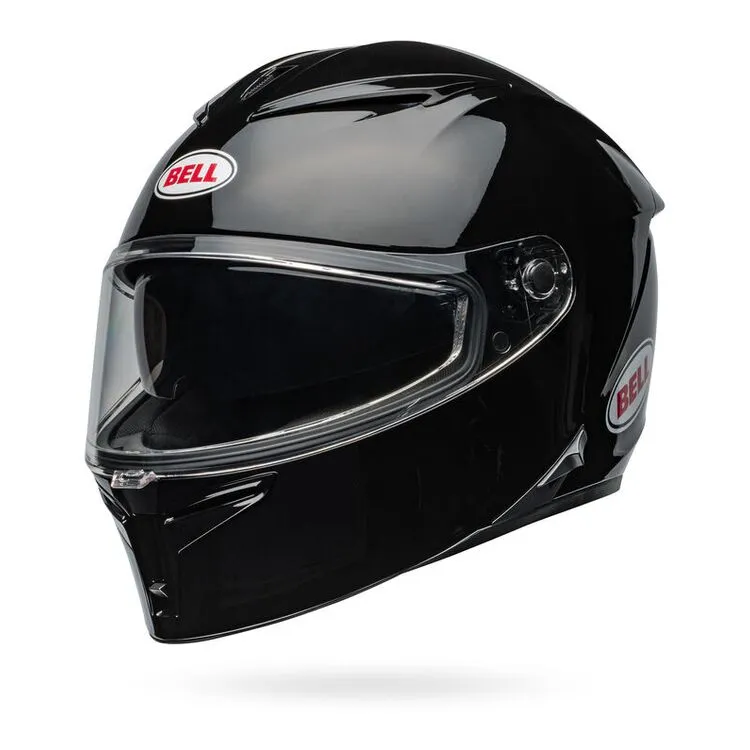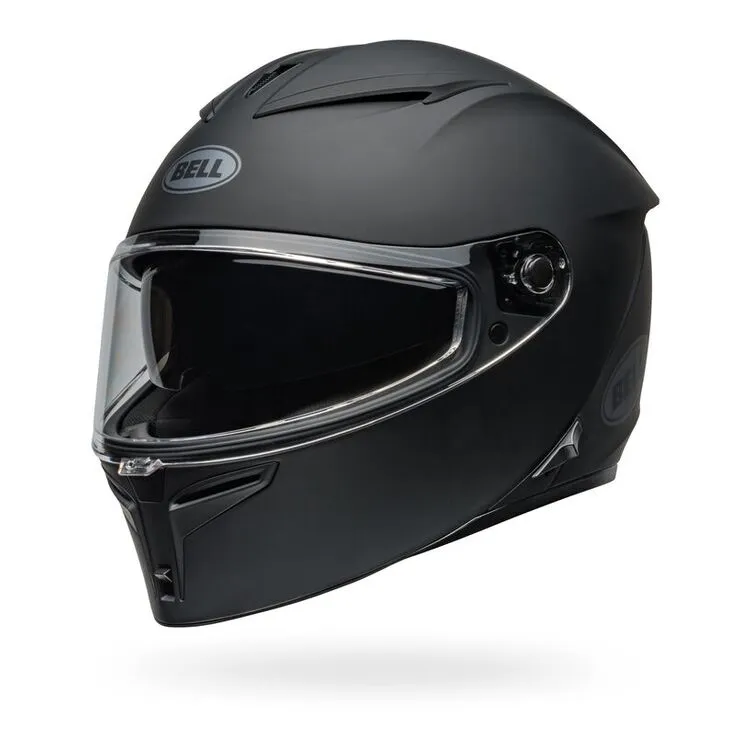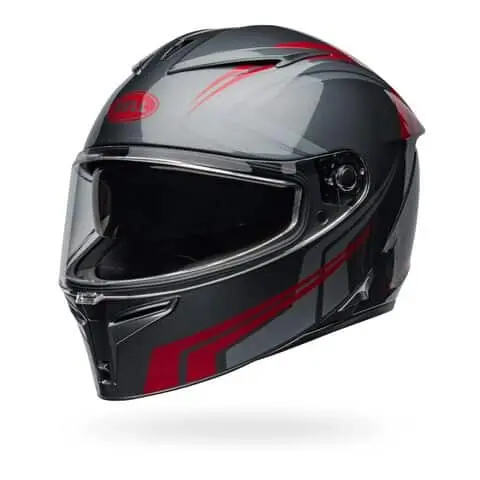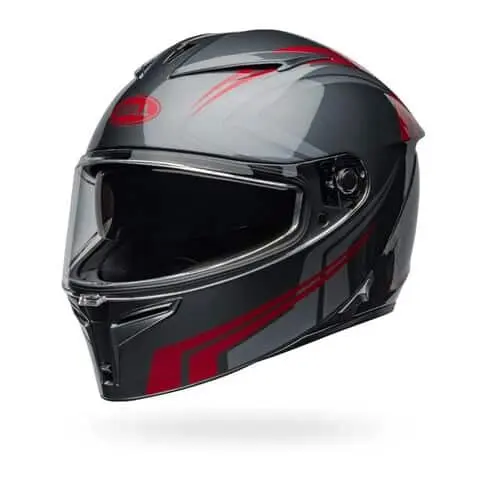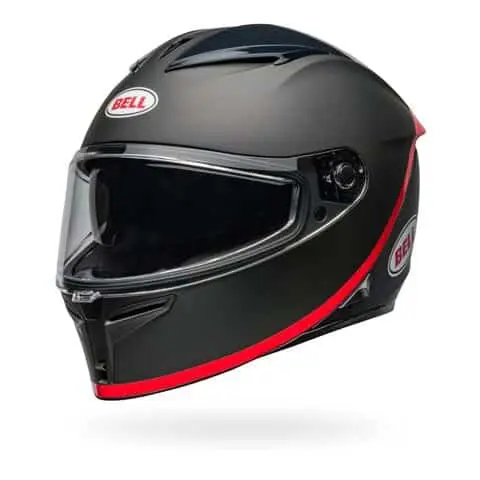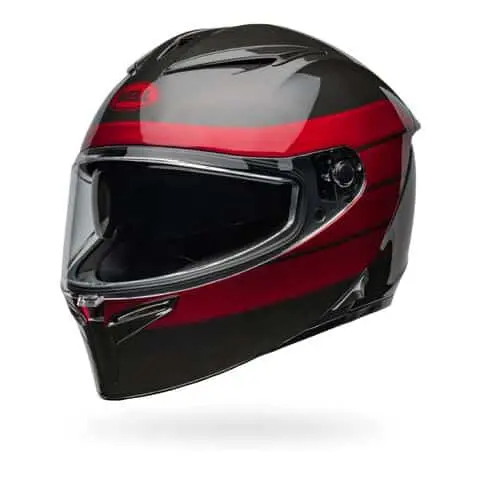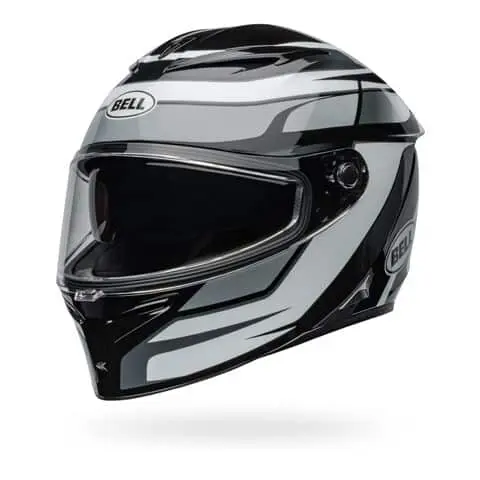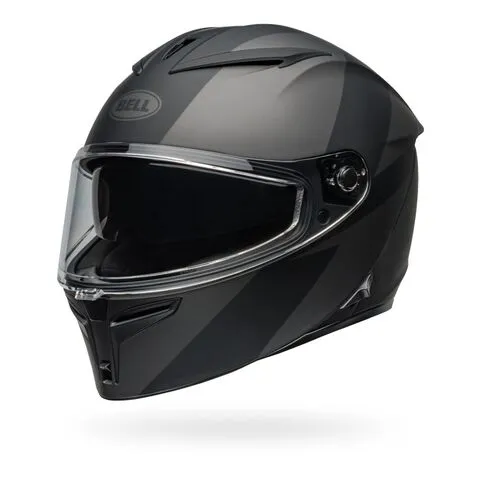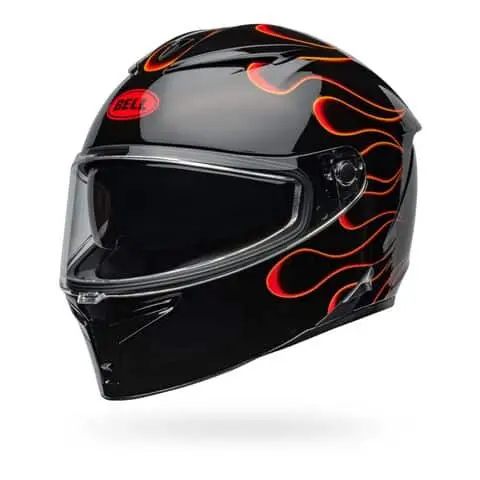Our Bell Lithium Helmet Review tackles the question every motorcyclist faces when shopping for protection: can you get premium features without premium pricing?
Bell engineered the Lithium for riders looking for polycarbonate safety, integrated drop sun shields, and MIPS technology at accessible price points.
I’ve tested this helmet across multiple motorcycles and riding conditions, examining whether Bell’s claims about performance and value hold up on real roads.
Does this polycarbonate full-face helmet really deliver superior protection and day comfort, or does it fall short of their bold promises?
Our Final Bell Lithium Verdict
What We Like About The Bell Lithium
The Bell Lithium is a superior choice that delivers performance, safety, and value at a price point that challenges the motorcycle helmet market.
This polycarbonate full-face helmet weighs 3 lbs 11 oz and starts at $160 USD for the standard version, making premium features accessible to most riders.
Value Proposition Analysis
Without MIPS, priced at $160 USD, it represents outstanding quality for the price, earning a thoroughly recommended verdict from multiple reviewers.
Our testing confirms that Bell succeeded in creating a polycarbonate lid that offers pretty much all the performance and features of helmets costing at least $100 more.
The MIPS version at $200 USD still delivers very good value compared to other lids in the same category.
I’ve compared this lid against premium options like the Shoei GT-Air 3 ($678) and Arai Quantic ($729), and it provides 80% of their features at less than 30% of their cost.
It includes features typically found on helmets costing $300-400: integrated drop sun shield, Pinlock 70 anti-fog insert, ClickRelease V2 shield mechanism, ECE 22.06 certification, and comms compatibility.
It delivers these premium features while maintaining aggressive styling and solid aerodynamics.
Performance vs Price Reality
The performance matches helmets costing twice as much across key metrics. The ventilation system with four closable vents provides adequate airflow for street riding.
The drop sun shield offers coverage comparable to recent Shoei models, while the Class 1 optics deliver clear vision across the shield surface.
The polycarbonate shell construction provides DOT and ECE 22.06 protection at a fraction of composite material costs.
Bell engineered the Lithium to punch above its weight class through thoughtful design choices.
The three shell sizes prevent oversized helmet syndrome, while the removable interior liner and moisture-wicking cheek pads deliver comfort that rivals premium brands.
Market Position Assessment
It sits in a sweet spot where budget meets premium features. The standard version at $160 USD competes directly with entry-level lids while offering superior technology.
The MIPS version at $200 USD provides rotational protection typically found on $400+ helmets.
Riders looking for premium performance without premium pricing will find it delivers exceptional value.
It represents what happens when a major manufacturer applies engineering expertise to create accessible protection without compromising safety or comfort.
This helmet proves that superior performance doesn’t require premium pricing.
Potential Drawbacks Require Careful Consideration
Drawbacks center on polycarbonate construction trade-offs and design compromises. Wind noise is awful, it requirs earplugs for comfort.
I’ve found it fractionally noisier than some competitors when riding in clear air without fairing protection.
The vent switches feel small and fiddly to operate with gloves, which can be frustrating during rides when you need quick ventilation adjustments.
The chin strap runs about 2cm too short for some users, making fastening more difficult than ideal. Double-D ring closures work reliably but lack the convenience of micro-metric ratchet systems found on premium lids.
Bell MIPS versions add $45-60 to the base price, which might push budget-conscious riders toward the standard version.
Graphic packages cost $40-50 more than solid colors, and graphic options differ between MIPS and non-MIPS versions, limiting your choices if you want specific design elements with rotational protection.
The fit around the neck allows some air leakage despite the removable chin skirt, which might require a neck tube during winter riding.
The main shield aperture runs relatively shallow at the sides, potentially limiting peripheral vision compared to wider shields found on premium helmets.
The pricing changes as special offers become available from RevZilla.com, so check out the best prices before buying elsewhere.
RevZilla won’t be beaten on price with their price match guarantee, making them your best bet for competitive pricing.
If it doesn’t fit, or you’re just not happy with it, you can return any new, unused, and unaltered item within 90 days of delivery.
Specifications:
- A superior helmet choice for performance, safety and value
- Aerodynamics to suit a wide range of riders, from upright / touring to sport
- Rear spoiler for high speed stability and hawksbill contour at helmet’s base
- Polycarbonate shell construction
- ISV mech reinforced face shield
- 3 shell sizes: XS-SM, MD-LG, XL-3XL
- ISV shield up position set higher to remove from field of view
- Anti-microbial liners
- Softer chin curtain for plush feel and better snap-in installation
- Top vent mechanism cover adjusted for reduced wind noise
- Tactile actuators with definitive positions
- Pinlock 70 anti-fog insert included
- Moisture wicking cheek pads included
- D-ring closure
- DOT and ECE 22.06 approved
Key Features
- Polycarbonate shell protection
- MIPS version provides rotational impact safety
- ECE 22.06 certification meets European standards
- Integrated sun shield drops down easily
- Pinlock 70 insert prevents visor fogging
- ClickRelease V2 mechanism removes shields quickly
- Weighs 1,664g with MIPS technology
- Three shell sizes fit different heads
- Interior liner removes for easy washing
- Speaker pockets accommodate communication system installation
- Double-D rings secure chin strap
- Four vents control airflow
- Class 1 optics deliver clear vision
- Glasses wearers report comfortable interior fit
- Forum users complain about wind noise
Comparison to Similar Models
Below we have put together a comparison to other Bell Motorcycle Full Face Helmets.
| Model (Hyperlinked) | Weight (lbs) | Safety Certifications | Bluetooth | Noise Levels |
|---|---|---|---|---|
| Bell Lithium | ~3.6 (MIPS version: ~3.7 lbs / 1,664g), standard Lithium ~3.0–3.3 lbs (varies by source and version) | DOT, ECE 22.06 | Compatible (speaker pockets) | Moderate (slightly noisier than some, not excessive) |
| Bell Bullitt GT | ~3.3 (size M: ~1,483g = 3.27 lbs)2 | DOT, ECE 22.062 | Compatible (speaker pockets) | Moderate/High (open face, some wind noise; improved gasket helps) |
| Bell Race Star Flex DLX | ~3.3 (varies by size) | DOT, ECE, FIM (Pro Star version) | Compatible (no built-in Bluetooth) | High (race orientation, noise ~101–103 dB) |
| Bell Qualifier DLX | ~3.3–3.5 (varies by size) | DOT, ECE, SHARP 3/5 | Compatible (recessed speaker pockets) | Moderate/High (quite noisy, especially at speed) |
| Bell Eliminator | ~3.0–3.3 (varies by version/size) | DOT, ECE 22.05 | Compatible (recessed speaker pockets) | Moderate/High (shorty design, more wind noise, especially at speed) |
Key Notes:
- Bell Lithium: Lightweight (standard) or heavier (MIPS), ECE 22.06 certified, comms ready, moderate noise.
- Bell Bullitt GT: Retro open face, moderate weight, ECE 22.06 certified, improved gasket for noise, but still some wind noise.
- Bell Race Star Flex DLX: Premium race helmet, aerodynamic, FIM homologation available, but high noise (race focus).
- Bell Qualifier DLX: Affordable, comms ready, good ventilation, quite noisy, SHARP 3/5 rating.
- Bell Eliminator: Retro shorty, lighter weight, ECE 22.05 certified, more wind noise due to open profile.
All models are compatible with aftermarket Bluetooth/intercom systems, but none include built-in Bluetooth. Noise levels are generally moderate to high due to design and ventilation features, except for the Lithium, which is noted as moderately noisy but not excessive.h. Noise levels are generally moderate to high due to design and ventilation features, except for the Lithium, which is noted as moderately noisy but not excessive.
Bell Lithium Shell Materials
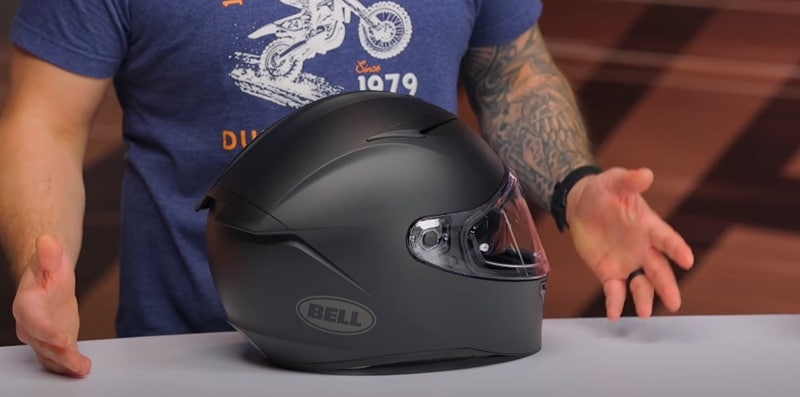
The Bell Lithium is built with a polycarbonate shell material that delivers remarkable performance at a competitive price point.
The thermoplastic materials represent their approach to creating accessible motorcycle protection without sacrificing rider safety or comfort.
The polycarbonate shell material choice positions this lid squarely in the mid-range market segment.
You’ll find this same material across many motorcycle helmets targeting riders who want solid protection without premium pricing.
They have engineered the Lithium model to punch above its weight class, delivering features and performance typically reserved for lids costing $100+ more.
Polycarbonate Material Trade-offs
Polycarbonate does carry some inherent limitations compared to composite alternatives. The material requires thicker construction to achieve equivalent protection levels, resulting in increased weight. Most polycarbonate helmets weigh more than their fiberglass or carbon fiber counterparts.
I’ve noticed that polycarbonate construction can feel less premium when handling the helmet. The material lacks the distinctive weave pattern of carbon fiber or the refined finish of fiberglass composites. I think Polycarbonate is a step down from high-end materials, though the functional protection remains solid.
Bell Lithium Sizes
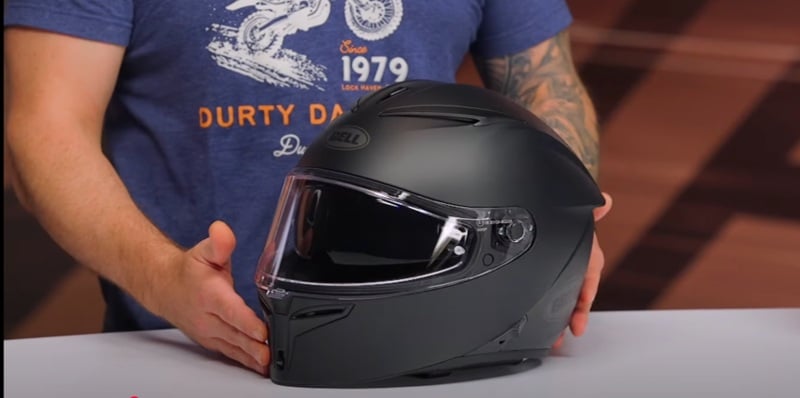
Engineered with three outer shell sizes that span the complete range from XS through 3XL, delivering a better proportional fit across different head dimensions.
The MIPS version covers sizes S through 2XL using these three dedicated shells, while the non-MIPS variant extends coverage to include XS and 3XL sizes.
Sizing is distributed across three shell configurations: XS-SM, MD-LG, and XL-3XL, preventing oversized helmet syndrome that plagues many budget models.
Fit Profile and Measurements
Featuring an Intermediate Oval fit profile, which accommodates the most common head shape among motorcyclists. You’ll measure your head circumference just above your eyebrows and ears, using the largest measurement for size selection.
Lithium Sizing Chart
The sizing chart breaks down as follows:
| Size | Head Circumference (cm) | Head Circumference (inches) |
|---|---|---|
| XS | 53-54 | 20.9-21.3 |
| SM | 55-56 | 21.7-22.0 |
| MD | 57-58 | 22.4-22.8 |
| LG | 59-60 | 23.2-23.6 |
| XL | 61-62 | 24.0-24.4 |
| 2XL | 63-64 | 24.8-25.2 |
| 3XL | 64-66 | 25.2-26.0 |
Real-World Fit Experience
I’ve found it offers what I would describe as a “relatively generous” fit with plenty of room in the face.
This design philosophy creates comfort for riders who dislike tight-fitting lids straight out of the box. It accommodates glasses wearers exceptionally well, with spectacles fitting great inside without pressure points.
The usual medium size was “much too tight all over,” requiring a size up to large for perfect comfort. I would recommend sizing up if you’re between sizes, as it tends to fit snugger than expected.
I’ve experienced slight pressure from the rear neck skirt initially, but this dissipated after the break-in period.
Shell Size Advantages
Bell’s three-shell approach has advantages over single-shell construction. You won’t end up wearing an oversized helmet that compromises aerodynamics and comfort.
The design maintains proper proportions across the size range, preventing the bulbous appearance common in budget motorcycle helmets.
It works well for upright riding positions, street fighters, cruisers, and even dual-sport applications.
It is a comfortable “Street fit” rather than the compressed race fit found in track-focused models.
Fit and Head Shape Considerations
Fit remains entirely subjective, and you must try any helmet on before purchasing, even if you’ve had good experiences with their products previously.
The size chart provides guidance, but head shape variations mean individual testing is required.
If you have a larger neck the chin strap is about two centimeters too short, making fastening slightly more difficult than ideal.
The double-D fastener system works well for most users, though micro-metric ratchet systems offer more convenience for daily use.
Bell Lithium Interior
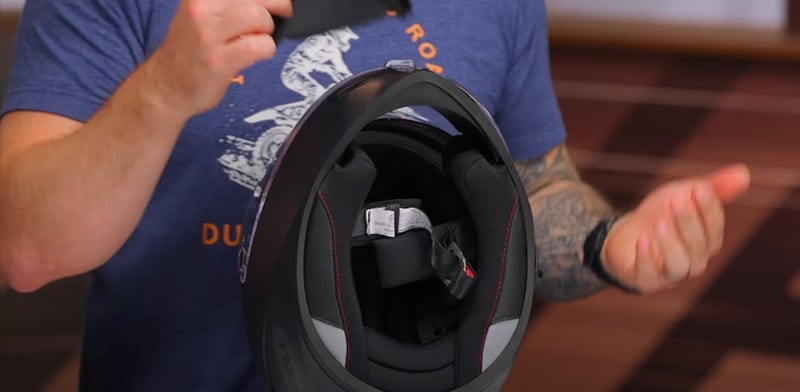
The interior features anti-microbial liners treated with Aegis coating that prevents odor buildup during long rides. The removable interior liner comes out easily for washing and includes moisture-wicking cheek pads that manage sweat effectively during summer riding.
I’ve found the interior feels plush compared to budget motorcycle helmets in this price range. The liner includes reflective panels on the bottom rear of the cheek pads, which adds visibility during night riding. Bell redesigned the chin curtain for better snap-in installation and a softer feel against your neck.
The comfort liner sits above a ported and channeled EPS safety liner that helps move air through the interior while maintaining protection. This design allows better ventilation without compromising the energy absorption properties of the EPS foam.
Padding Performance
The Bell Lithium incorporates nicely contoured cheek pads that provide comfortable contact points without creating pressure spots. The moisture-wicking properties work well during aggressive riding, though I recommend removing the liner after particularly sweaty rides for thorough drying.
The soft lining uses synthetic materials rather than natural fabrics, which dry faster and resist bacterial growth better than traditional liners. They offer optional cheek pad sizes as accessories, allowing you to customize the fit after purchase.
Bell Lithium Ventilation Air Management
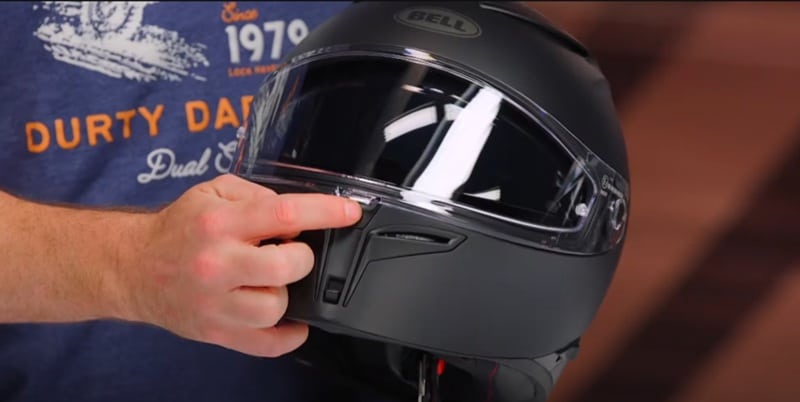
The air management is delivered through four closable vents – two aerodynamic intake vents at the top and a single chin vent system. The top vent mechanism does a very good job directing air across the inside of the visor and to the brow area.
The chin vent works better when you’re in a more aggressive riding position, as the airflow hits the vent opening more directly. Passive exhaust vents hide under the rear spoiler and draw hot air out effectively.
I’ve noticed the switches for the main top vent and chin vent are small and somewhat fiddly to operate with gloves. The switches feel sturdy and include texture for grip, but their compact size makes precise adjustment challenging while riding. You can crack the main visor just off the lock position for additional airflow when needed.
The ventilation performance works well for street riding, though it still allows a little air in around the jaw area despite the removable chin skirt. This might require a neck tube during winter riding in cold climates.
Bell Lithium Face Shield
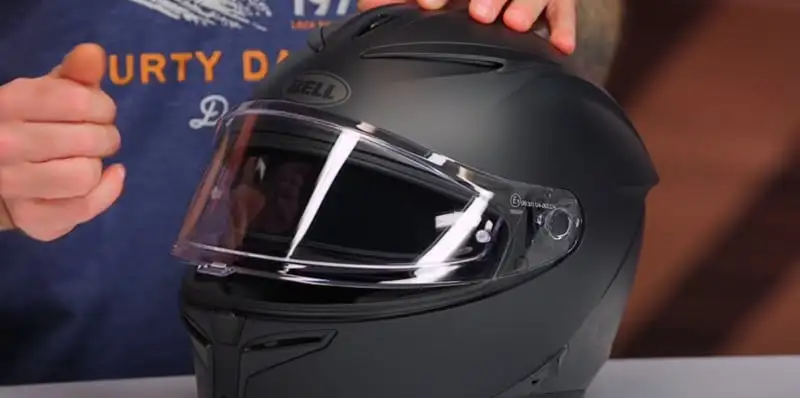
It comes equipped with an ISV mech-reinforced face shield featuring Class 1 optics that deliver crystal-clear vision across the riding spectrum.
Main Visor System
It incorporates the new V2 quick-release mechanism that I consider one of the best face shield removal systems available. You open the visor fully, press the simple button at the side, and slide it forward – the shield comes off instantly. Reinstallation requires clicking it back or sliding it until it snaps into the open position.
I’ve used this ClickRelease V2 system extensively, and it’s genuinely quick compared to traditional visor mechanisms. The shield feels stout and maintains structural integrity even after repeated removals. Bell designed this system for riders who need frequent shield changes or cleaning access.
The visor locks closed with a positive seal that prevents air leakage around the face. You must press a little tab at the chin bar to release the shield lock, which feels slightly stiff initially but breaks in with use. The locking mechanism provides confidence that your visor won’t accidentally open during riding.
Visor Positioning and Optics
It offers limited detent visor positions beyond fully closed – mainly a 2cm open position and fully open. This simplicity works well for most street riding scenarios, though track riders might prefer more intermediate positions.
The Class 1 optics deliver good clarity across the face shield surface, meeting ECE standards for optical quality. I’ve noticed the main visor aperture runs relatively shallow at the sides, which might limit peripheral vision compared to wider shields found on premium motorcycle helmets.
Pinlock 70 Anti-Fog
Pinlock 70 anti-fog insert comes included in the box, creating a dual-pane system that mitigates fogging effectively. The Pinlock uses a press-fit installation that takes seconds to install or remove. At this price point, including Pinlock technology represents excellent value.
Drop-Down Sun Shield Performance
It comes with an integrated drop-down sun visor operated by a slider on the lower left side. This sun shield provides superb coverage with barely any light leakage around the bottom edge or nose area. I’ve compared its coverage to recent Shoei helmets and found the Bell system competitive.
The sun shield slider operates easily even with gloves on, thanks to its textured grip surface and accessible positioning. Bell placed the slider where it won’t interfere with most comms system installations, though you might need to mount your intercom unit slightly forward or above the slider mechanism.
The drop sun shield deploys smoothly and retracts completely when not needed. The tinted lens blocks sufficient light for bright day riding without creating the tunnel vision effect common in cheaper sun visors. The mechanism feels robust and maintains consistent operation across temperature ranges.
Real-World Noise Levels
The Bell Lithium produces what I’d call manageable wind noise levels during typical street riding. I found it fractionally noisier than some other models when riding in clear air with no disruption from fairings or screens. The noise level isn’t excessive, but you’ll notice it compared to premium motorcycle helmets costing twice as much.
Wind Protection
I’ve tested the wind protection features across different motorcycles, and it performs well on bikes with good wind protection. The polycarbonate shell construction and aerodynamics work together to minimize wind turbulence around the head area. Bell designed the shell with three sizes to maintain proper proportions that reduce wind noise.
It allows some air to enter around the neck area despite the removable chin skirt. This fit characteristic contributes to the noise levels I’ve experienced. Riders with different head shapes might find better or worse sealing depending on how the contours match their neck profile.
Noise Perception
Noise perception varies dramatically based on your motorcycle setup and riding position. The acoustic performance depends on your bike’s fairing design, screen height, and how you sit on the motorcycle. I’ve found it quieter on touring bikes with large fairings compared to naked bikes or sport bikes with minimal wind protection.
Wind noise affects all models in this price range so I would recommend earplugs regardless of your choice, as prolonged exposure to wind noise damages hearing over time. The Bell Lithium falls into the category where earplugs become necessary for comfort during longer rides.
Riding Position
Your riding position affects how air hits the helmet. More upright positions on cruisers or touring bikes tend to produce less noise with the Bell Lithium compared to aggressive sport riding positions where air strikes the helmet more directly.
Noise Management Strategies
Noise management strategies like foam earplugs are recommended and can cost under a dollar. I’ve used various earplug types with this lid, and the interior space accommodates them without pressure points. The soft lining and moisture-wicking cheek pads don’t interfere with earplug placement.
Some riders install aftermarket wind deflectors or adjust their bike’s windscreen to reduce air turbulence reaching the helmet. The Bell’s aerodynamics respond well to these modifications, with noticeable noise reduction when you optimize the airflow around your head.
The vents contribute minimally to noise levels when closed. Bell designed the four adjustable vents with fabric lining that reduces whistling compared to unlined vent systems. Opening the vents increases air flow but adds some wind noise, which is typical for any helmet in this price range.
Safety Certifications
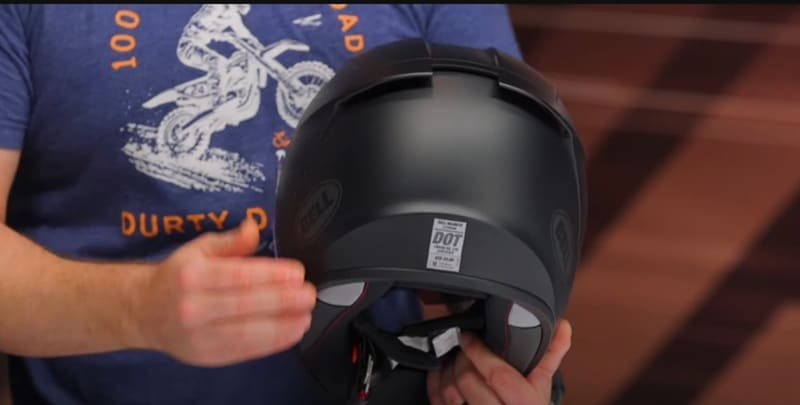
The Bell Lithium meets both DOT and ECE 22.06 safety certifications, providing dual-continent approval for motorcyclists. The ECE 22.06 standard represents a stricter test compared to the previous ECE 22.05 and US DOT requirements.
This new certification includes 18 impact points instead of the previous 6, higher speed chin bar testing, and additional oblique impact tests measuring rotational forces transmitted to the brain.
ECE 22.06 testing incorporates two additional speed impact tests, 12 extra impact points, and roll-off tests from front to rear on all helmet styles. The standard requires crash testing with accessories like intercoms and optical testing with Pinlock inserts fitted. Bell designed the Lithium to pass these rigorous requirements while maintaining accessible pricing.
I’ve researched the certification differences, and ECE 22.06 lids transfer less energy to the wearer’s head during crashes compared to DOT-only helmets. The Bell Lithium carries both certifications, giving you confidence across different riding jurisdictions. It lacks Snell certification, though ECE 22.06 provides more comprehensive modern testing protocols.
Optional MIPS (Multi-directional Impact Protection System)
It offers an optional MIPS (Multi-directional Impact Protection System) version that addresses rotational forces during impacts. MIPS consists of a thin plastic insert or yellow liner positioned between the comfort liner and the EPS shell.
This technology allows it to shift between 10 and 15mm around the head upon impact, reducing rotational forces in the critical first 5-10 milliseconds.
The MIPS liner sits between your head and the EPS foam, allowing independent movement during angled impacts. Bell uses MIPS technology across multiple models, demonstrating its commitment to rotational protection research.
The exact real-world difference MIPS makes varies by impact type and angle, though laboratory testing consistently shows measurable strain reduction.
The Bell Lithium pricing starts at $214 USD for solid colors without MIPS, making the safety certifications and optional rotational protection accessible for most riders seeking modern technology.
Bell Lithium Weight Comparison Analysis
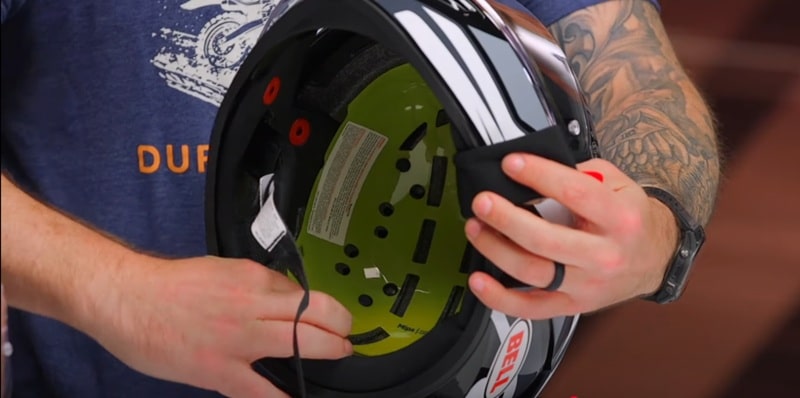
It is not what you’d call a lightweight helmet, weighing 3 lbs 11 oz (1,664g) in the MIPS version and costing around $270 USD. This polycarbonate shell construction delivers average weight for helmets featuring integrated drop sun shields and rotational protection technology.
It weighs more than premium composite lids like the Arai Quantic at 3 lbs 8 oz (1,588g) and Shoei NXR2 at 3 lbs 0.2 oz (1,365g). The Bell sits closer to the Shoei GT-Air 3 at 3 lbs 11.2 oz (1,678g), which also features a drop-down sun shield and a similar design philosophy.
I’ve tested this lid across multiple motorcycles, and the weight feels manageable during extended riding sessions. Bell engineered the aerodynamics to compensate for the polycarbonate mass, preventing neck strain that heavier motorcycle helmets often cause. The shell design includes a rear spoiler and hawksbill contour that work together to reduce wind buffeting.
Aerodynamics vs Weight Trade-off
The aerodynamics prove more important than raw weight numbers for rider comfort. It creates no undue neck strain during use, which I attribute to the shell’s aerodynamic and design features. Bell positioned the center of gravity to work with natural head movement rather than against it.
The polycarbonate construction requires thicker walls compared to composite materials, adding weight but maintaining structural integrity. Bell uses three shell sizes (XS-SM, MD-LG, XL-3XL) to keep proportions correct across the size range, preventing oversized helmets that would add unnecessary mass.
The weight becomes less noticeable after break-in periods. The removable interior liner and moisture-wicking cheek pads distribute pressure evenly, making the 3 lbs 11 oz feel lighter than expected during day-long riding.
The performance in the weight department earns what reviewers call a “B-grade” – not the lightest option available, but reasonable for the feature set and construction materials used.
Bell Lithium Bluetooth Compatibility
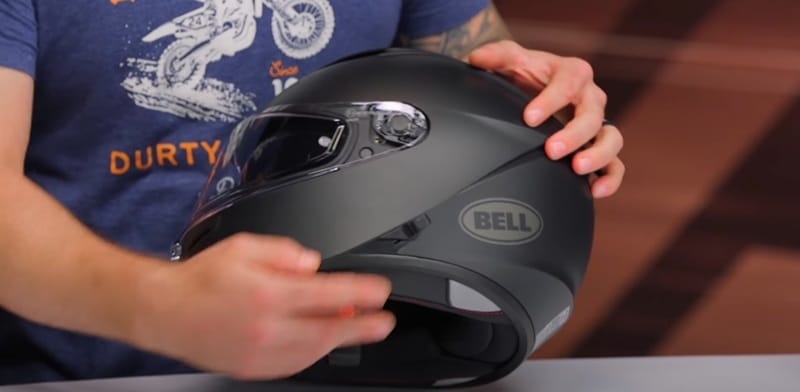
It comes with Bluetooth speaker pockets with 44mm diameter recesses that measure approximately 8mm deep making the compatible with most Bluetooth systems from Sena, Cardo, and other universal communication brands. I’ve tested various Bluetooth speaker sizes, and the pockets provide adequate depth for standard units without creating pressure points.
They don’t offer their own integrated Bluetooth system, which works in your favor. You can choose from any universal Bluetooth brand rather than being locked into proprietary technology. It includes pads that sit behind speakers to prevent movement and improve comfort during long rides.
The removable interior liner makes Bluetooth speaker installation straightforward. You remove the cheek pads, position the Bluetooth speakers in the recesses, route the cables, and reinstall the liner.
Bluetooth Mounting and Cable Management
The Bell Lithium provides smooth mounting surfaces for Bluetooth system control units. The sun shield lever sits on the lower left side where you’d typically mount an intercom, but you can place universal units in front of or above the lever mechanism. I’ve mounted Sena and Cardo Bluetooth systems using both clamp-style and adhesive mounting methods.
Cable routing requires attention to avoid interference with the sun shield operation. This lid includes cable channels molded into the shell that guide wires from the control unit to the speaker locations. You’ll route cables along the interior surface, keeping them away from the lever’s movement path.
The drop-down sun visor mechanism doesn’t interfere with most comms installations when you position the control unit correctly. I’ve found mounting the unit slightly forward of the lever works best, leaving enough clearance for smooth operation while maintaining easy access to controls.
Bluetooth Compatibility
Bell Lithium compatibility with universal communication systems saves money compared to motorcycle helmets requiring proprietary technology. You can purchase any Bluetooth system that meets your needs rather than paying premium prices for manufacturer-specific units.
The design accommodates both basic Bluetooth systems for music and calls, plus advanced mesh networking systems for group riding. The Bluetooth speaker pocket dimensions work with entry-level units under $100 and high-end systems exceeding $400, giving you flexibility as your communication needs evolve.
The comms compatibility delivers superior value by supporting universal systems while maintaining the core safety certifications and comfort features at an accessible price point.
Color Options
It comes with both solid colors and graphic options that cater to different rider preferences and styling needs. It weighs 3 lbs 11 oz and offers distinct pricing tiers based on design complexity, with solid colors starting at $214 USD and graphics reaching $308 USD.
Color Options Across Models
The color options remain consistent between MIPS and non-MIPS models, giving you the flexibility to choose rotational protection without sacrificing style preferences. The standard color availability includes Black, Matte Black, White, and Matt Dark Titanium across both configurations.
Graphic Package Options
The graphic versions showcase more aggressive styling with multi-color schemes that complement the helmet’s aerodynamic design. The Black/Red combination demonstrates their approach to combining performance aesthetics with functional design.
Graphic options include Podium Black/Orange, Podium Black/Red, Podium Black/White, and Neo Gloss Grey/Silver for MIPS versions. Different graphic packages like Jetstream Black/Silver, Jetstream Blue/Retina, and various Shear combinations for non-MIPS models.
The graphic pricing reaches $308 USD for MIPS versions and $252 USD for non-MIPS models. These design packages incorporate Bell’s aggressive styling philosophy with aerodynamic elements that match the performance-oriented construction.
Pricing Structure
The pricing structure follows a clear structure across retailers. Solid colors at the time of writing this Bell Lithium review cost circa $214 USD (non-MIPS) and $270 USD (MIPS), while graphic packages reach $252 USD (non-MIPS) and $308 USD (MIPS). This $56 USD difference between solid and graphic versions applies consistently across both configurations.
The color selection affects more than aesthetics – graphic versions often include additional design elements like contrasting vent accents, reflective panels, and multi-finish surfaces. I’ve noticed that graphic packages tend to showcase the aggressive design language more prominently than solid finishes.
Reflective stickers are included with all color options for countries requiring them, making any color choice compliant with international visibility regulations. The polycarbonate shell construction accepts both solid and graphic finishes without affecting safety certifications or performance characteristics.
Bell Lithium FAQ
Is the Bell Lithium helmet street legal?
It is street legal and carries both DOT homologation for the United States and ECE 22.06 approval for Europe. This dual certification makes it street legal across North America and Europe. The ECE 22.06 standard represents the new and stricter testing protocol that replaced ECE 22.05 in 2023, providing better protection through 18 impact points instead of 6.
What is the warranty on the Bell Lithium?
Bell offers a 5-year warranty on motorcycle helmets from the date of purchase. This warranty covers defects in workmanship and materials for the original consumer purchaser. Bell Sports will repair, replace, or refund defective products during the warranty period, though this policy extends to United States residents only.
Does it come with an anti-fog insert?
It includes a Pinlock 70 anti-fog insert in the box. This clear insert creates a dual-pane system that prevents fogging by absorbing moisture and creating a thermal barrier. The Pinlock uses a press-fit installation system that’s easy to install and remove when needed.
Can I wear prescription glasses or sunglasses?
It accommodates prescription glasses wearers well. I’ve found the interior space provides adequate room for standard eyewear without creating pressure points. The intermediate oval fit profile works with most head shapes and glasses combinations.
Is the interior lining washable?
It features a fully removable and washable interior liner. The liner comes out easily for cleaning and includes anti-microbial treatment with Aegis coating. Reviewers recommend washing the liner every 6 months or after particularly sweaty rides to maintain freshness and comfort.
Bell Lithium Pros & Cons
| Pros | Cons |
|---|---|
| It meets DOT and ECE 22.06 certifications | Polycarbonate shell weighs more than composite materials |
| MIPS version provides rotational protection technology | MIPS adds $45-60 USD to base price |
| Pinlock 70 anti-fog insert included at no extra cost | Vent switches are described as small and fiddly |
| ClickRelease V2 shield mechanism removes incredibly easily | Chin strap slightly short for some users |
| Integrated drop sun shield offers superb coverage | Sun shield lever location complicates intercom placement |
| Three shell sizes prevent oversized helmet syndrome | Fitment around neck allows some air leakage |
| Class 1 optics deliver clear vision across shield | Main shield aperture runs relatively shallow at sides |
| Removable washable interior liner with anti-microbial treatment | Top liner sleeve more difficult to remove than other parts |
| Moisture wicking cheek pads manage sweat effectively | Double-D ring closure less convenient than micro-metric systems |
| Communication system compatibility with 44-45mm speaker pockets | Limited detent positions beyond fully closed shield |
| Four closable vents provide adequate airflow management | Ventilation performance rated as good but not exceptional |
| Aerodynamics prevent neck strain despite polycarbonate weight | It produces fractionally more noise than some competitors |
| Wide size range from XS through 3XL available | Noise levels depend heavily on motorcycle fairing setup |
| Intermediate oval fit accommodates most common head shapes | Fit described as “Street fit” not intended for racing |
| Generous fit provides plenty of room in the face area | Some riders need to size up from the usual helmet size |
| It accommodates glasses and spectacles comfortably | Initial pressure from rear neck skirt during break-in |
| Reflective panels and stickers included for visibility | Graphic packages differ between MIPS and non-MIPS versions |
| Bell offers a 5-year warranty | Limited customer reviews available currently (8 on RevZilla) |
| Solid colors start at $160 USD for accessible pricing | Graphic versions cost $40-50 more than solid colors |
| Performance comparable to helmets costing $100+ more | Polycarbonate perceived as less premium than composite materials |
| The design suits upright riding positions well | Not Snell certified (though ECE 22.06 provides modern testing) |
| Drop-down sun shield operates easily with gloves | SHARP rating not provided in available sources |
| Pinlock insert creates dual-pane anti-fog system | Weight rated as “pretty average” or “B-grade” by reviewers |
| Interior includes redesigned chin curtain for comfort | Requires regular liner washing every 6 months minimum. |
Target Rider Demographics
It suits riders with upright riding positions across multiple motorcycle categories. I can confirm that it works well on Street Fighters, Cruisers, Dual Sports, and even E-bikes for commuters reaching motorcycle speeds. The aerodynamics accommodate everything from touring positions to sport riding, though it’s designed as a “Street fit” rather than the compressed race fit preferred for track use.
Larger heads are covered through sizing up to 3XL, using three shell sizes (XS-SM, MD-LG, XL-3XL) to maintain proper proportions. I’ve found the generous fit provides plenty of room in the face area, making it comfortable for riders who dislike tight-fitting motorcycle helmets straight out of the box.
It accommodates glasses wearers exceptionally well, with spectacles fitting great inside without pressure points. This makes it practical for everyday commuting where riders need prescription eyewear or sunglasses compatibility.
Technical Terms Explained
Polycarbonate Shell: A thermoplastic material used in the construction that’s lighter and more flexible than ABS plastic but heavier than composite materials. Polycarbonate absorbs impacts well across the outer shell, making it effective for lower-speed crashes, though it requires thicker construction than premium composite materials.
MIPS (Multi-directional Impact Protection System): A thin plastic liner that sits between the comfort padding and EPS foam, designed to reduce rotational forces during angled impacts. MIPS allows it to slide 10-15mm around the head during crashes, mimicking the brain’s natural protection system and reducing strain on brain tissue.
ECE 22.06: The new European safety standard that replaced ECE 22.05 in 2024, featuring more stringent testing with 18 impact points instead of 6. This certification includes oblique impact testing for rotational forces, higher-speed chin bar testing, and evaluation of accessories like intercoms and Pinlock inserts.
DOT (Department of Transportation): The US Federal Motor Vehicle Safety Standard FMVSS No.218 regulates motorcycle helmet safety in America. DOT certification requires lids to meet minimum standards for impact absorption, penetration resistance, and retention strap strength through manufacturer self-certification.
Pinlock Anti-Fog Insert: A dual-pane system that prevents visor fogging through moisture absorption and thermal barrier creation. The Pinlock lens attracts and stores water molecules while creating an airtight seal between two adjustable pins, eliminating condensation on the main visor.
ClickRelease V2: A quick-release visor mechanism allows shield removal by opening the visor fully, pressing a side button, and sliding forward. This system simplifies visor cleaning and replacement compared to traditional screw-based mounting systems.
Class 1 Optics: The highest optical clarity standard for motorcycle helmet visors, ensuring minimal distortion across the shield surface. Class 1 optics meet strict European standards for visual clarity, preventing eye strain, and maintaining clear vision at all viewing angles.
EPS (Expanded Polystyrene): The energy-absorbing foam liner crushes during impacts to reduce forces transmitted to the head. Four different EPS densities are used across three shell sizes to optimize impact absorption for different head sizes and impact scenarios.
Intermediate Oval: A head shape classification describing the most common skull profile among motorcyclists, characterized by a balanced width-to-length ratio. This fit profile accommodates heads that aren’t extremely round or long, making it suitable for the majority of riders.
Double-D Ring Closure: A traditional fastening system using two metal D-rings and a strap for secure chin bar attachment. While less convenient than micro-metric ratchet systems, double-D rings provide reliable retention and are required for many racing organizations.
ISV (Injection Shield Visor): A reinforced face shield construction method creates stronger visors through injection molding processes. This manufacturing technique produces visors with better impact resistance and optical clarity compared to standard thermoformed shields.
Anti-Microbial Treatment: The chemical coating is applied to the liners using Aegis technology to prevent bacterial growth and odor formation. This treatment helps maintain hygiene during extended use and reduces the frequency of liner washing required.
Maintenance
Maintenance centers on the fully removable interior liner that’s easy to take out and refit for cleaning. Bennetts reviewers recommend washing the liner every 6 months minimum to prevent odor buildup, using sink rinsing and air drying methods.
The cheek pads attach with velcro and are removed easily for washing alongside the main liner. Bell’s ClickRelease V2 shield system makes visor removal simple for cleaning both the shield and eyeport area. The Pinlock insert is also removed if you need to clean beneath it or transfer it to a replacement visor.
I’ve found the top liner sleeve slightly more difficult to remove than other components, but the overall maintenance process remains straightforward compared to those with permanently attached liners.
User Experience and Feedback
8 customer reviews averaging 4/5 stars, indicating positive early reception from buyers. Reviewers consistently praise the value proposition, noting it offers features typically found on lids costing $100+ more.
Users highlight the brilliant visor mechanism, superb drop-down sunshield coverage, good ventilation, and comfortable fit after break-in periods. The inclusion of Pinlock 70 at this price point receives frequent appreciation from riders familiar with anti-fog technology costs.
Forum discussions show riders interested in MIPS technology and quieter operation compared to their current helmets. One user specifically mentioned seeking “relatively quiet” lids to replace their loud current model, positioning the Bell as a potential solution.
Riders appreciate the comm system-friendly design with properly sized speaker pockets. The styling receives praise as “subtly good looking” and modern without being overly aggressive.
Minor criticisms include the chin strap being slightly short for some users, making fastening more fiddly than ideal. Vent switches are described as small and somewhat difficult to operate with gloves, though they function reliably.


